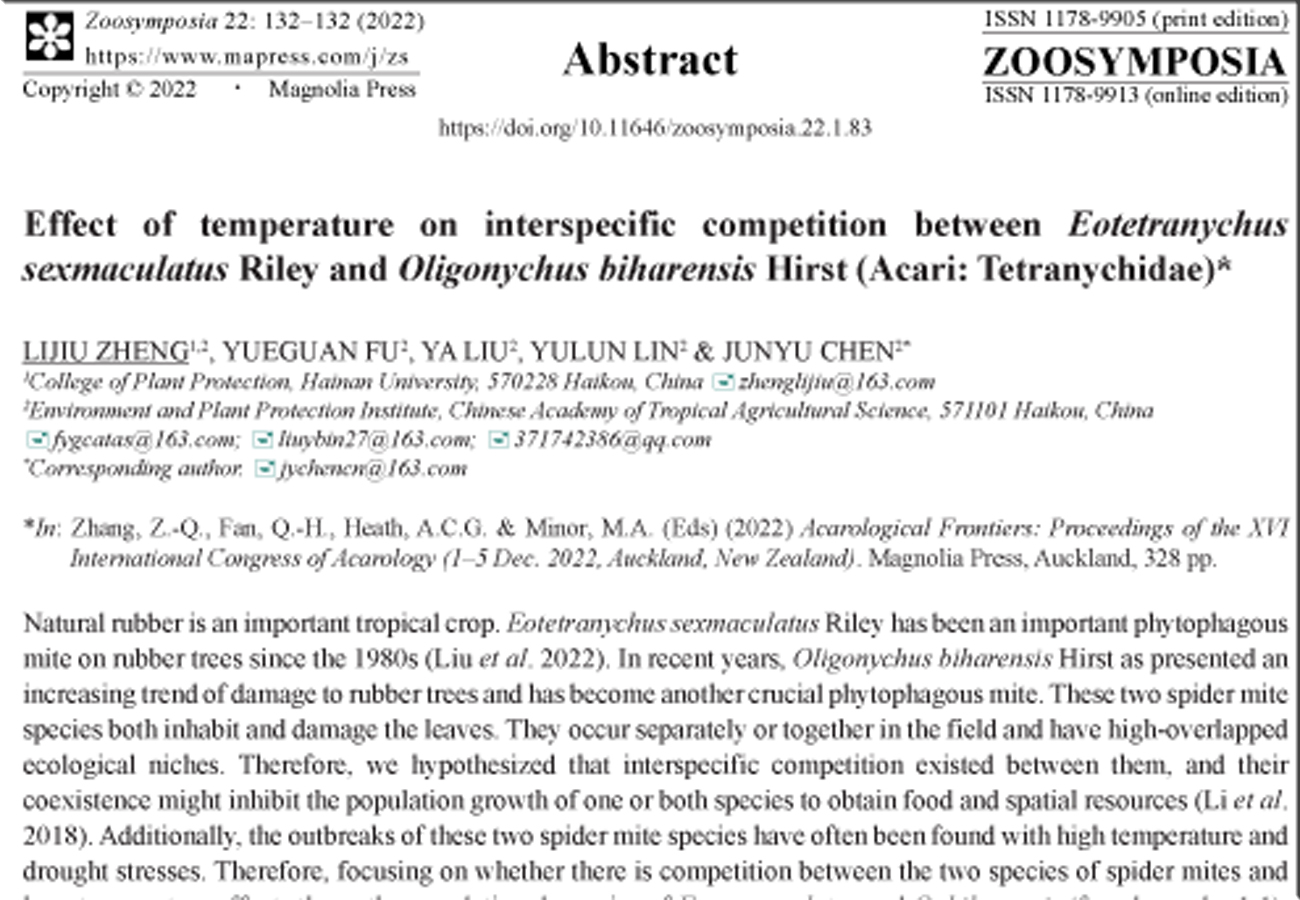Abstract
Natural rubber is an important tropical crop. Eotetranychus sexmaculatus Riley has been an important phytophagous mite on rubber trees since the 1980s (Liu et al. 2022). In recent years, Oligonychus biharensis Hirst as presented an increasing trend of damage to rubber trees and has become another crucial phytophagous mite. These two spider mite species both inhabit and damage the leaves. They occur separately or together in the field and have high-overlapped ecological niches. Therefore, we hypothesized that interspecific competition existed between them, and their coexistence might inhibit the population growth of one or both species to obtain food and spatial resources (Li et al. 2018). Additionally, the outbreaks of these two spider mite species have often been found with high temperature and drought stresses. Therefore, focusing on whether there is competition between the two species of spider mites and how temperature affects them, the population dynamics of E. sexmaculatus and O. biharensis (female: male=1:1), and their mixed populations were assessed at 27, 30, and 33°C. For each treatment, 30 pairs of spider mites were used. There are five starting densities of E. sexmaculatus and O. biharensis individuals: 30 vs. 0, 0 vs. 30, 10 vs. 20, 15 vs. 15, and 20 vs. 10, respectively. The virgin male and female adult mites were picked and transferred onto the rubber leaves (96 cm2). These mites were reared in climate chambers with different temperatures and the leaves were replaced regularly. The numbers of each mite stage were recorded every 5 days. The experiments ended when one of the spider mite species was extinct in the mixed populations. The results showed interspecific competition existed between E. sexmaculatus and O. biharensis. Either pure population of two spider mites was greater in numbers than the mixed populations. The populations of E. sexmaculatus were significantly suppressed by O. biharensis. The mean and peak values of the innate capacity of increase (rm) were greater in O. biharensis than E. sexmaculatus in all treatments, indicating that O. biharensis was more competitive than E. sexmaculatus. Additionally, E. sexmaculatus was rapidly replaced by O. biharensis with the increased temperature, regardless of their starting densities. At 33°C, the highest interspecific competition coefficients were obtained (0.5695 and 0.6188, respectively) when the mixed populations of E. sexmaculatus and O. biharensis were 10 vs. 20 and 20 vs. 10. In conclusion, O. biharensis was more competitive than E. sexmaculatus at all tested temperatures, regardless of their starting densities.
References
Liu, Y., Nie, Y., Chen, J.Y., Lu, T.F., Niu, L.M., Jia, J.J., Ye, Z.P. & Fu, Y.G. (2022) Genetic diversity of three major spider mites damaging rubber trees. Systematic and Applied Acarology, 27(10), 2025–2037. https://doi.org/10.11158/saa.27.10.13
Li, J.L., Liu, S, Guo, K., Zhang, F., Qiao, H.L., Chen, J.M., Yang, M.K., Zhu, X., Xu, R. & Xu, C.Q. (2018) Plant-mediated competition facilitates a phoretic association between a gall mite and a psyllid vector. Experimental and Applied Acarology, 76(3), 325–337. https://doi.org/10.1007/s10493-018-0315-2

